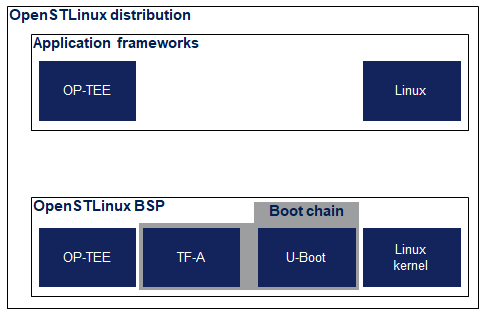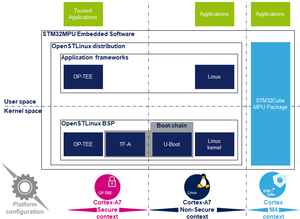This message will disappear after all relevant tasks have been resolved.
Semantic MediaWiki
There are 1 incomplete or pending task to finish installation of Semantic MediaWiki. An administrator or user with sufficient rights can complete it. This should be done before adding new data to avoid inconsistencies.Registered User mNo edit summary |
Registered User No edit summary |
||
| Line 27: | Line 27: | ||
<noinclude> | <noinclude> | ||
{{PublicationRequestId | 5963 | 2018-01-25 | AlainF}} | {{PublicationRequestId | 5963 | 2018-01-25 | AlainF}} | ||
[[Category:Architecture overview|02]] | [[Category:Architecture overview|02]] | ||
</noinclude> | </noinclude> | ||
Latest revision as of 18:12, 4 February 2020
The OpenSTLinux distribution encompasses the following components:
- The OpenSTLinux BSP that offers services, to the application frameworks in the same context, from:
- The boot chain based on TF-A and U-Boot
- The OP-TEE secure OS running on the Cortex-A in secure mode
- The Linux® kernel running on the Arm® Cortex®-A in non-secure mode
- The Application frameworks that rely on the services provided by the OpenSTLinux BSP, to provide particular functionalities (code libraries, APIs, tool sets...) to facilitate the development of software applications:
- The Linux application frameworks (aka Linux middlewares) running on the user space of the Linux OS: e.g. libusb C library for a generic access to USB devices, ALSA user-space bundle for audio functionalities, GStreamer multimedia framework...
- The OP-TEE application frameworks running on the user space of the secure OS: e.g. TEE Internal core API for the development of Trusted Applications (TA)
- The U-Boot application frameworks: e.g. configuration scripts
The figure below is clickable so that the user can directly jump to one of the sub-levels listed above.

OpenSTLinux architecture overview
